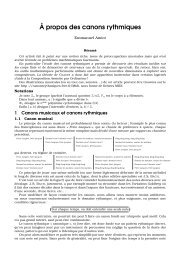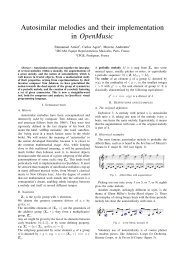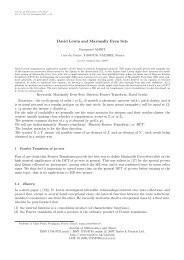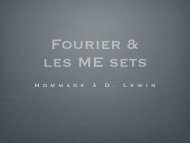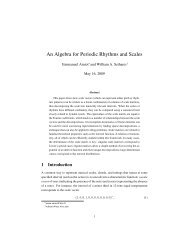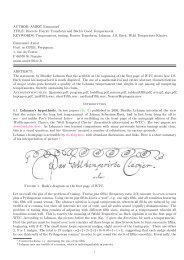Emmanuel Amiot Modèles algébriques et algorithmes pour la ...
Emmanuel Amiot Modèles algébriques et algorithmes pour la ...
Emmanuel Amiot Modèles algébriques et algorithmes pour la ...
Create successful ePaper yourself
Turn your PDF publications into a flip-book with our unique Google optimized e-Paper software.
alternative title 3<br />
Lemma 1.2 The Fourier transforms of a pc-s<strong>et</strong> A and of its complement Zc \ A have opposite values,<br />
except when t = 0:<br />
∀t ∈ Zc, t = 0, F Zc\A(t) = −FA(t)<br />
Furthermore, we g<strong>et</strong> F Zc\A(0) = FA(0) if and only if Card A = c/2, as<br />
Lemma 1.3 The Fourier transform of A in 0 is equal to the cardinality of A: FA(0) = Card A.<br />
For other coefficients, taking into account lemma 1.2 and the triangu<strong>la</strong>r inequality one g<strong>et</strong>s<br />
Lemma 1.4 ∀ t ∈ Zc, t = 0 ⇒ |FA(t)| ≤ min(d, c − d).<br />
The DFT FA characterizes the pc-s<strong>et</strong> A, by the following identity (Inverse Fourier transform)<br />
1A(t) = 1<br />
c<br />
<br />
k∈Zc<br />
e +2ik tπ/c FA(k)<br />
easily derived from the definition of FA. Thus the DFT yields the same information as the pc-s<strong>et</strong>, but in<br />
a form that stresses musically relevant concepts. More precisely, there is preservation of the absolute value<br />
of DFT under all usual 1 musical transformations. For instance,<br />
Theorem 1.5 The length of the Fourier transform, i.e. the map |FA| : t ↦→ |FA(t)|, is invariant by<br />
(musical) transposition or inversion of the pc-s<strong>et</strong> A. More precisely, for any p, t ∈ Zc<br />
• FA+p(t) = e −2ipπt/c FA(t) (invariance under transposition)<br />
• F−A(t) = FA(t) (invariance under inversion)<br />
and also under complementation (except in 0 when Card A = c/2).<br />
L<strong>et</strong> us say that A, B are Lewin-re<strong>la</strong>ted when maps |FA| and |FB| are identical. It is the case whenever<br />
A, B are exchanged by the T/I group of musical transformations, but the reverse is not true (see below).<br />
All the same, the map |FA| appears to be a very good snapshot of the relevant musical information of a<br />
given pc-s<strong>et</strong>: by dropping the information of the phase of the Fourier coefficients and r<strong>et</strong>aining only the<br />
absolute value, we seem to keep the best part, in a way reminiscent of the Helmoltzian approach of sound,<br />
which showed that the phase of a sine wave can (mostly) be neglected, as the frequency is the part that<br />
generates the perception of pitch. This strongly vindicates and to some measure extends Quinn’s ( [17])<br />
notion of ‘chord quality’, which appears in the <strong>la</strong>st section of his dissertation with a value that is precisely<br />
|FA(d)|, d = Card A, and is measured in ‘lewins’.<br />
As as nice application of these invariance properties, we may characterize periodic subs<strong>et</strong>s:<br />
Proposition 1.6 A ⊂ Zc is periodic , meaning A + τ = A for some τ, if and only if FA(t) = 0 except<br />
when t belongs to some subgroup of Zc.<br />
The proof is left to the reader (see also Supplementary II online).<br />
Remark 1<br />
• Some may well c<strong>la</strong>im this proposition is obvious: a subs<strong>et</strong> A ∈ Zc is the s<strong>et</strong> of residues of a periodic<br />
s<strong>et</strong> A ⊂ Z, with period c. This periodicity means precisely that 1A (or 1 b A , with the same formu<strong>la</strong>) can<br />
be expressed as a combination of c exponential functions, the t ↦→ e 2iπ k t/c : this is the inverse Fourier<br />
transform formu<strong>la</strong> and the very reason Fourier transform works. The existence of a smaller period m | c<br />
means that m exponentials functions only are sufficient, e.g the t ↦→ e 2iπ k t/m .<br />
• In Z12, the octatonic scale (0 1 3 4 6 7 9 10) is an interesting example of such a periodic subs<strong>et</strong>. Its<br />
group of periods is 3 Z12. Periodic subs<strong>et</strong>s of Z12 are well known as Messiaen’s Modes à Transposition<br />
Limitées.<br />
1 Less usual transformations, like t ↦→ 7t mod 12, permute the Fourier coefficients.




